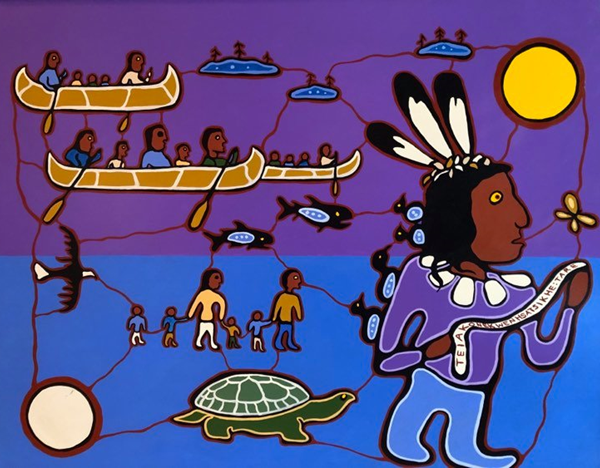Community engagement and mobilization is a key component of this study and will be woven throughout FEHNCY activities. This component will focus on developing activities to engage community members and youth, valuing Indigenous knowledge, and developing strong relationships with First Nations communities.
All in-person data collection for FEHNCY is currently on hold to comply with the physical and social distancing recommendations issued by the provincial and federal governments. The FEHNCY team will be conducting remote only data collection and will continue modifying the project methods, timeline, and protocols in collaboration with First Nation partners to adapt to the current circumstances. The mobile clinic component has been postponed until further notice.
COMMUNITY ENGAGEMENT AND MOBILIZATION
Valuing Indigenous Knowledge
- Opening ceremony (informed by Haudenosaunee traditional protocols) to introduce the members of the research team to the community, including the Community Research Team and university researchers.
- Teiakonekwenhsatsikhetare (Our blood is sweet) historical wampum bundle. The FEHNCY Team is honored to carry the wampum belt bundle from Joe Jacobs, an elder from Kahnawake. The idea to create the wampum belt came to Joe in a dream. He knew that he must bring the message the belt carried to different Indigenous communities to raise awareness that diabetes can be overcome. As the belt was carried by foot/bike/canoe to Indigenous communities from 1997-2017, the Wampum Belt grew in size, just as awareness grew. In 2019, Treena Delormier (Kahnawake) and Brittany Jock (Akwesasne) discussed how the FEHNCY study can be understood as carrying a message. Treena, who knew Joe from Kahnawake and diabetes prevention, sought his guidance on how the wampum belt could be translated to the FEHNCY study. In response, Joe offered the belt to FEHNCY to carry on the message of ensuring healthy future generations of children. We are carrying on this legacy by bringing this story to communities participating in FEHNCY and continuing to share the message of wellness and collective action to address the needs of First Nations children and youth. Communities will be invited to contribute to the Teiakonekwenhsatsikhetare message by incorporating their wishes for youth health in the bundle. The Wampum Belt is a work of art-in-progress, to which communities participating in FEHNCY can contribute.

Artwork by Norman Achneepineskum
Depicting Joe Jacobs traveling with the Teiakonekwenhsatsikhetare wampum belt.
- Community Advisory Circle. Advisory circles will consist of members of the participating First Nation (youth leaders, elders, and other community members). Advisory circles will guide study activities and provide input on recruitment, engagement of youth, community outreach, and data analysis to ensure that the research is being conducted in a good way. We thank Norma Kassi from Old Crow YK who provided Treena and Brittany guidance on CACs when we attended the Seeds of Native Health Conference in 2019.
- Promoting cultural safety. Promoting respectful and partnership approaches for the FEHNCY team in working with Indigenous communities and families.
- Closing ceremony (informed by Haudenosaunee traditional protocols) to thank the First Nation for their collaboration, acknowledge the responsibility that we carry in returning results, and use the FEHNCY study results to promote the health and wellness of First Nations youth.
Establishing Relationships
- Agreements between the First Nation and the project will outline each party’s responsibilities and will be signed before starting the study.
- Presentations with Regional First Nations organization(s) and in each of the randomly selected First Nations.
- Regional workshop to discuss the study in detail and adapt aspects of the methodology according to each First Nation’s unique circumstances.
- Identifying and connecting with community partners.
- Opening ceremony in each community.
- One-on-one interviews with local knowledge holders and experts in community food access.
- Workshops and regular community presentations to promote FEHNCY, give updates on study progress, and engage with First Nations about what is meaningful to them.
- Ongoing activities to promote youth engagement, participation, and co-learning will take place throughout the FEHNCY study period.
Maintaining Respectful Relationships by Understanding Community Perspectives
- Mapping activity with children and youth to understand their perspectives of their food environment and their food practices.
- Sharing preliminary results from interviews and mapping activity.
- Giving updates to the community on study progress.
- Connecting with community partners to discuss how FEHNCY results can inform local/regional/national advocacy.
Communicating Results and Applying Knowledge
- Approximately one year after the end of data collection, a draft report and presentation will be shared with each participating First Nation community members and leadership. Community feedback will be incorporated into the final reports.
- Approximately two years after the end of data collection, the FEHNCY Team will return final community and regional reports.
- Workshop to return community-specific data and reports to each Nation and train community members on basic statistics, applying for funds, and to brainstorm on grassroots, regional, and national programs and policies to improve the health and environment of First Nations children and youth.
- Continued discussions with community partners for translating results to promote First Nations and youth health.
